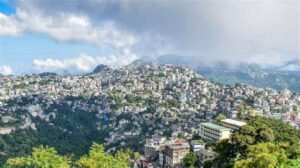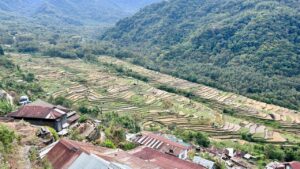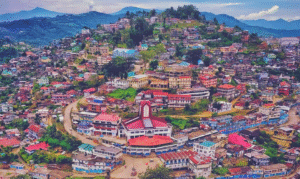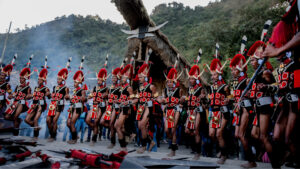Introduction: A Unique Wonder of Nature
Keibul Lamjao National Park is not like any other national park in the world. Located in the state of Manipur in Northeast India, this park is special. It floats. Yes, you read that right. It is the only floating national park on Earth.The park is part of Loktak Lake, a large freshwater lake known for its “phumdis” – floating masses of vegetation, soil, and organic matter. Keibul Lamjao sits on these phumdis and supports unique wildlife and communities that live in harmony with nature.
Historical Roots: From Sacred Land to Protected Area
The region around Loktak Lake has always been important to the people of Manipur. The lake and its floating islands were once home to small villages and were used for fishing and farming.In 1977, the government declared Keibul Lamjao a national park. This decision was made mainly to protect the endangered Sangai deer – also known as the Manipur brow-antlered deer – which was on the verge of extinction. The park became a symbol of conservation and local pride.
Language and Communication: Voices from the Valley
The main language spoken around Keibul Lamjao is Meiteilon or Manipuri. It is the official language of Manipur. Other languages spoken include Thadou, Tangkhul, and other tribal dialects.Signboards, information materials, and educational programs at the park are often in Meiteilon and English. Language plays a key role in spreading awareness about conservation and cultural identity in the region.
Festivals and Celebrations: Nature in Local Culture
Although Keibul Lamjao itself is not a place for festivals, the people who live nearby celebrate events deeply connected to nature. The Sangai Festival, named after the rare deer found only here, is held annually in Manipur. It raises awareness about the park and its wildlife. Local communities also observe traditional Meitei festivals like Lai Haraoba, which includes dance and rituals to please forest and water spirits, showing their deep respect for natural forces.
Arts, Crafts, and Music: Reflections of a Floating World
The floating life of Keibul Lamjao influences local art. Artists depict the phumdis, deer, and lake scenes in paintings, sculptures, and folk songs. Bamboo and water reeds are used to create household items, fishing tools, and even musical instruments.Local music uses folk instruments like the pena and tells stories of life near Loktak Lake. Nature, animals, and the seasons are common themes in these artistic expressions.
Cuisine and Culinary Traditions: From the Waters to the Plate
Food around Keibul Lamjao is based on what nature provides. Fish from Loktak Lake is a staple. People also eat water plants, snails, and fermented fish known as “ngari.” Rice, vegetables, and herbs grown nearby form the rest of the meal. Most dishes are steamed or boiled, with very little oil. The food is simple but healthy and closely tied to the environment.
Attire and Ornamentation: Identity in Fabric
Traditional clothing in Manipur reflects both tribal and valley cultures. Women wear a wrap-around cloth called “phanek” and a shawl known as “inaphi.” Men wear dhotis and jackets during special occasions. Jewelry made from silver, beads, and brass is common. Designs often feature symbols from nature like fish, deer, or water lilies – all of which are part of the Loktak ecosystem.
Beliefs and Values: Living in Harmony
The people around Keibul Lamjao believe in living in balance with nature. Many follow Sanamahism, the indigenous religion of the Meitei people, which teaches respect for earth, water, and all living beings. Even today, elders teach children to fish sustainably, protect the lake, and avoid harming the deer. These values are passed down through generations and guide everyday life.
Customs and Etiquette: Respect Rooted in Culture
Politeness, community living, and respect for elders are important in local customs. Fishing areas and phumdis are often shared by families and villages. Conflicts are resolved through community talks. Visitors and outsiders are expected to respect local traditions. Elders are greeted with respect, and rituals are observed during harvests and important life events.
Architecture and Symbols: Life on the Lake
Houses near the lake are often built on stilts to stay above the water. Some structures even float on phumdis. Fishing huts and temporary shelters are made from bamboo and palm leaves. Symbolically, the Sangai deer represents grace and strength. It appears in folk stories, carvings, and government emblems. The deer has become a mascot for conservation in Manipur.
Oral Traditions and Storytelling: Wisdom of the Elders
Stories about Loktak Lake and Keibul Lamjao are told from one generation to another. Elders speak of times when the lake was larger, and the Sangai roamed freely. Tales often include magical deer, water spirits, and brave fishermen. These oral stories are more than entertainment—they teach values of care, caution, and community.
Interactions with Nature: Floating Lives and Sustainable Living
The people living around Keibul Lamjao have a deep connection with the lake. Fishing, collecting water plants, and farming are all done with care. They use hand-made boats to move around the floating lands. The park itself is home to many rare birds, fish, and animals. The phumdis act as breeding grounds and natural filters for the water. Everything is connected in this unique ecosystem.
Challenges and Preservation: A Delicate Balance
Keibul Lamjao is under threat. Climate change, pollution, and dam construction have affected the natural water flow. This makes the phumdis thinner and weaker. The Sangai deer is still endangered. It depends on healthy phumdis to survive. Human activities like overfishing and unplanned development are also risks. Efforts are being made to save the park. Local communities, the government, and conservation groups are working together. Eco-awareness programs and stricter protections have helped, but more is needed.
Contributions to the Region and World: A Symbol of Coexistence
Keibul Lamjao National Park is a rare example of a floating ecosystem that supports both people and wildlife. It has taught the world about adaptive living, sustainable fishing, and harmony between humans and nature. It has also contributed to science. Researchers study its unique biodiversity, floating landforms, and animal behavior. The park is a living lab for conservation biology and wetland management.
Connection to Northeast India: A Jewel in the Crown
Keibul Lamjao is a key part of Northeast India’s ecological and cultural diversity. It shows the richness of indigenous knowledge and the region’s commitment to protecting its natural heritage. The park represents more than Manipur. It speaks for the many hidden wonders of Northeast India – a region full of stories, traditions, and rare ecosystems.
Floating Towards the Future
Keibul Lamjao National Park is a miracle of nature. It floats, but it is grounded in strong traditions, local wisdom, and ecological importance. As the only floating national park in the world, it teaches us that life can adapt, survive, and thrive when it respects nature. Its future depends on how well we protect it today. Through education, awareness, and community efforts, this park can remain a symbol of hope and harmony for generations to come.






